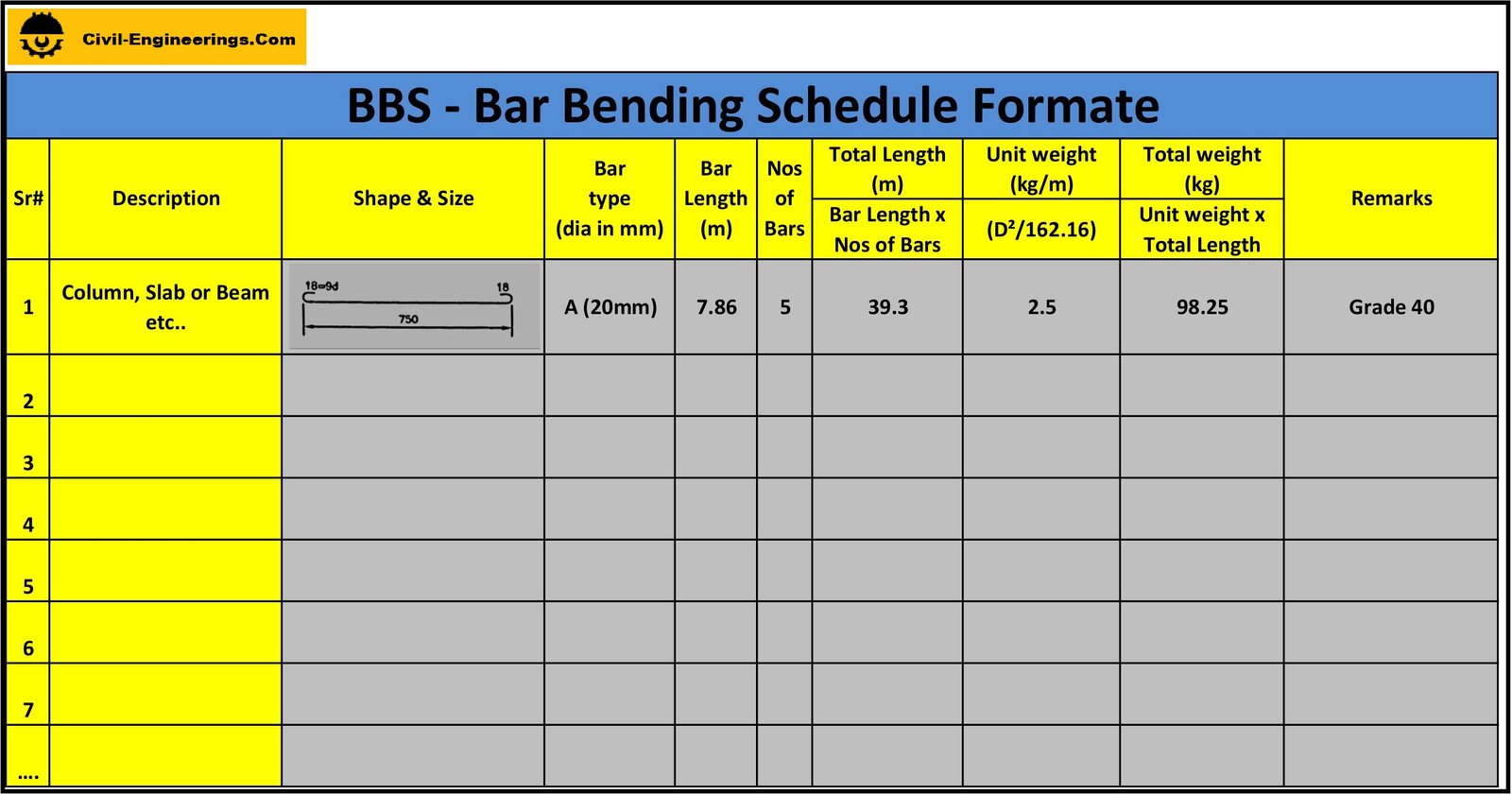Table of Contents

Introduction
A bar bending schedule (BBS) is a working document in civil/construction engineering that outlines the details of reinforcement bars used in R.C.C structures. It is used as a reference for the quantity and specifications of steel reinforcement needed for a construction project. Details of what a bar bending schedule typically includes are as follows:
- Bar Identification: Each bar has its own identification in the bar bending schedule.
- Bar Shape: Details about the shape and bending of each bar, often represented in a diagram.
- Quantity: The total number of each type of bar required for the project.
- Length: The length of each bar before bending and the cut length after accounting for bends.
- Bend Details: Specifications for the type of bends, such as the angle and radius.
- Weight: The weight of each bar type, often calculated using the formula: Weight of steel bar = Density x Volume or Square of Dia (mm)/162.16
- Total Weight: The overall weight for each type of bar by multiplying the weight of each bar by the number of bars.
- Location: Reference to where the bars will be used in the structure (e.g., columns, beams, slabs).
Components of a Bar Bending Schedule
- Project Information:
- Project Name: The name of the construction project.
- Location: The location of the project.
- Client/Owner: The name of the client or owner of the project.
- Consultant/Engineer: The name of the consulting engineer or architect.
- Bar Details:
- Bar No: A unique identifier for each type of bar in the schedule.
- Type of Bar: The designation of the bar (e.g., T8, T10, T12), referring to the diameter of the bar in millimeters.
- Length before Bending: The initial length of the bar before any bending.
- Length After Bending: The final length after accounting for bends.
- Bend Angle: The angle at which the bar is bent (e.g., 90°, 180°).
- Shape Description: A brief description or code for the shape of the bar (e.g., L-shape, U-shape).
- Quantities and Weights:
- Quantity: The number of bars of each type required for the project.
- Unit Weight: The weight of each bar type, calculated using different formulas (e.g., Weight of steel bar = Density x Volume or Square of Dia (mm)/162.16).
- Total Weight: The overall weight for each type of bar by multiplying the weight of each bar by the number of bars.
- Bending Details:
- Bend Radius: The radius of the bend, crucial for ensuring the structural integrity of the bar.
- Concrete Cover: The distance from the outer surface of the concrete to the nearest surface of the reinforcement, essential for corrosion protection.
- Additional Notes:
- Any special instructions or notes regarding handling, transportation, or placement of the bars.
Preparation of Bar Bending Schedule
- Design Drawings: Start with the structural design drawings, which indicate the reinforcement requirements for different structural elements.
- Identify Reinforcement Needs: Extract the required reinforcement details from the drawings, including types, sizes, and locations of bars.
- Calculate Lengths and Quantities: Measure and calculate the lengths and quantities of reinforcement bars based on the design.
- Draft the Schedule: Organize the information into a tabulated format, ensuring clarity and ease of understanding.
- Review and Verification: Review the BBS with the structural engineer and site manager to ensure accuracy and compliance with the design.
Importance of Bar Bending Schedule
- Cost Control: Helps in estimating material costs accurately, allowing for better budgeting and financial planning.
- Efficient Material Use: Provides precise measurements and quantities, reducing wastage during cutting and bending.
- Facilitating Procurement: Ensures timely procurement of reinforcement bars based on the project schedule, preventing delays.
- Quality Assurance: Maintains consistency in reinforcement quality by providing clear guidelines for fabrication and placement.
- Project Management: Assists in scheduling labor and equipment for steel cutting, bending, and installation, improving project efficiency.
- Documentation: Serves as a reference during inspections and audits, ensuring compliance with design specifications and standards.
